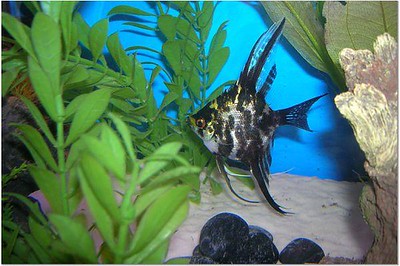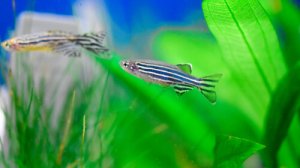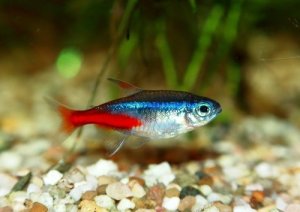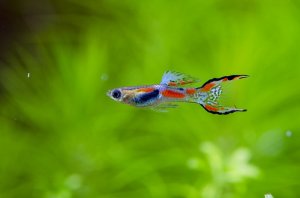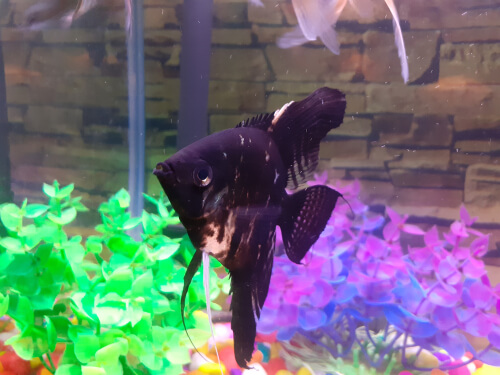
Angelfish in general are extremely unique and beautiful animals with varied finnage and many color schemes. The Angelfish is a member of the Cichlidae family.
Angelfish have been referred to as the “Kings of the Aquarium” according to trusted sources. The Black Angel Fish is an Especially sought after and exquisite beauty.
Breed Overview
| Origin | The Black Freshwater Angelfish originates from South America. |
| Lifespan | It has a Lifespan of around 10-12 years in captivity and up to 15 years in the wild. |
| Size | They are around 6 inches in length and 8 inches or more in height. |
| Colour | Solid Black or Black Marble variations for the Black Angelfish. |
| Food | Omnivorous. |
| Tank Size | A taller Tank of around 20 -30 gallons. |
| Temperament | They are Peaceful and School, however Territorial as they get older. |
| Water Type | Freshwater, Clear or Silty Water, that is soft and acidic. |
| Water Temperature | Water temperatures between 26-30 degrees Celsius, or (75-86 Fahrenheit). |
| Water pH | A slightly acidic to neutral pH of between 6.0 and 7.0 neutral. Nitrates must be below 100 Mg and Water Hardness of between 0-6. |
| Difficulty Level | Easy for Beginners. |
Species Information
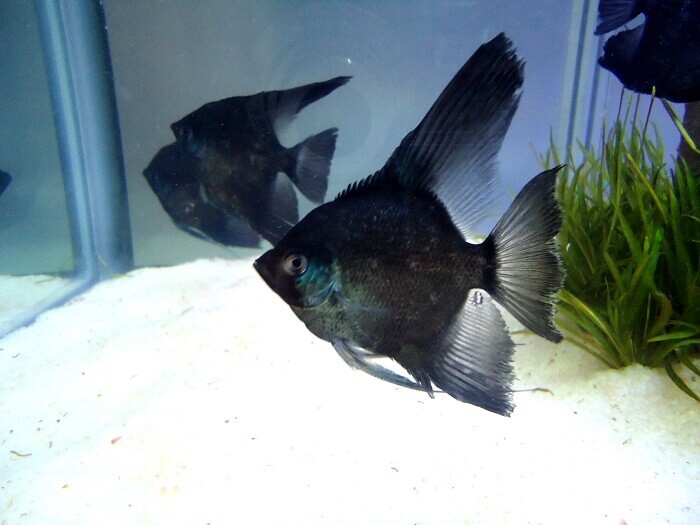
There are three commonly kept species of FreshWater Angelfish, the Pterophyllum Scalare which is the most common, the Pterophyllum Altum, and the Pterophyllum Leopoldi the rarest.
The Black Angelfish forms part of the Pterophyllum Scalare species, one of the more common captive-bred Angelfish species that is naturally found in South America.
Freshwater Angelfish such as the Black Angelfish are known for their more laterally compressed bodies and larger dorsal and Ventral Fins that end in filaments. They have what is called a Delta shape, which helps them to hide among plants and roots, and even on vertical surfaces, according to Wikipedia.
Most Angelfish Species including the Black Angelfish is also known as ambush predators may prey on smaller fish.
Color Variations Of The Black Freshwater Angelfish
Freshwater Angelfish do come in many color variations, however, we are concentrating more on the Black Angelfish variation. There are two main Black Angelfish color variations available, the solid black, and the marbled black angelfish;
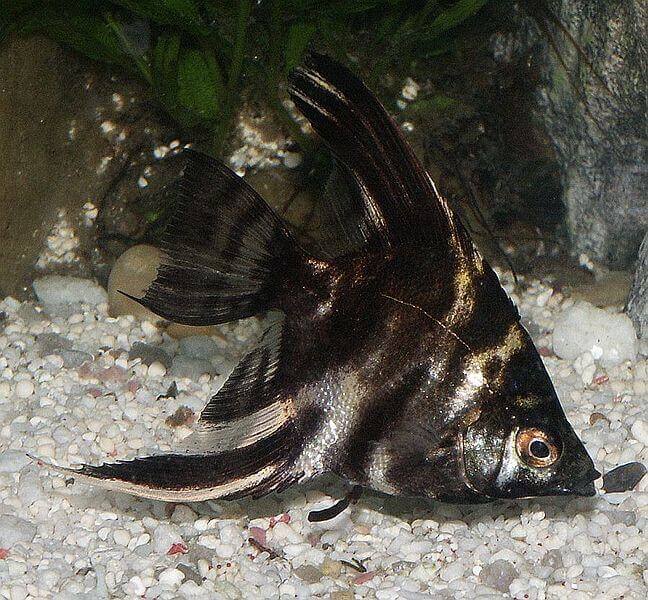
The Black, or Double Dark Angelfish as it is known will have a completely black body and sometimes slight patterning within the black, however never white, they mostly also have red eyes. The Black Marble Angelfish on the other hand will have black and white marbled patterns, and sometimes even Gold marbled patterns.
Black And White Angelfish
Black and White Angelfish can have a basic black-and white color with black being the dominant color. Then again there is a variation called the Panda color where white is the dominant color with solid black markings. The Black Lace Angelfish is predominantly black, with lighter patterns on the tail that resemble patterns of lace.
Black Angelfish Size
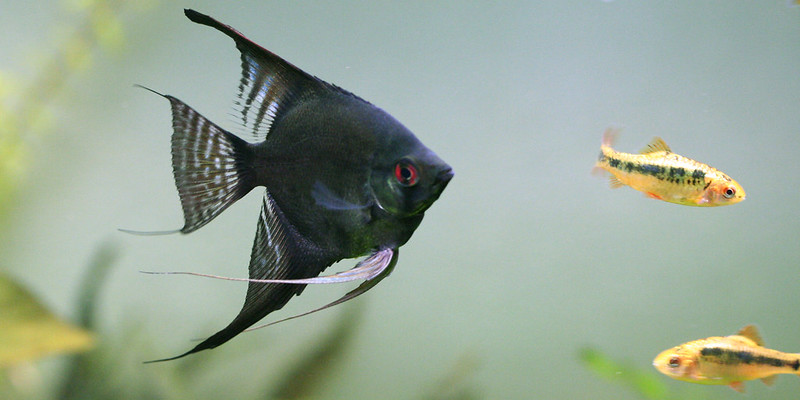
The Black Angelfish has more of a diamond shape, and a compressed rounder body with more triangular-shaped dorsal and anal fins. They will usually reach a size of 6 inches in length, and 8 inches or more in height when in captivity. Though Wild Freshwater Angelfish can reach larger sizes.
General Care
Angelfish in general are very easy to keep in an aquarium even for beginners. They prefer warmer and slightly acidic to neutral pH water, and under the right conditions they will thrive.
Once they are in an established tank with all the right water conditions and parameters, and if you keep up with feeding them a healthy balanced diet, there should be no issues with this gorgeous species of Freshwater Fish.
So first things first, let’s get you started on setting up your tank;
Setting Up Your Tank

Setting up the right sized tank, with proper water parameters and conditions for your Black Angelfish, along with some fun decorations and the right tank mates ensure that you have a happy and healthy Angelfish for quite a few years to come.
1. Selecting The Right-Sized Tank
We start off with the size of the tank for your fish, keep in mind they grow more in height than in length, so you want to opt for a higher tank. The tank for a single angelfish should be around 30 Gallons bare minimum. For every additional Angelfish 20 gallons should be added to your tank.
2. Tank Light
Angelfish naturally live in more shaded areas with sunlight filtered by trees and plants. They do need some light to help them differentiate between day and night. You can use artificial light or place them in an area with indirect sunlight and mostly filtered light, but more shade.
3. Water Conditions And Filtration
In general most Freshwater Angelfish species prefer slightly acidic clear, or silty water conditions with soft water. The water pH levels should be around ph 6.0- ph 7.0 which is just between acidic and neutral. Nitrates in the water should be below 100 mg, and they enjoy temperatures that are higher, around 26-to 30 degrees Celsius, or (75-86 Fahrenheit).
The water hardness should be around 4-8 dHG. Keep in mind that during Spawning and breeding, there may need to be some changes made to water conditions and temperatures. A filter with a slower moving current will be ideal as Angelfish do not produce excessive waste, and are not the strongest swimmers.
4. Decorating Your Tank
Decorating your tank is your own preference, whoever creates a more natural and serene environment for your Angelfish would be ideal. You can likewise make use of a decal at the back of the tank with natural scenery.
5. Substrate For Black Angelfish
We will start off with substrate to add to the bottom of your tank. Angelfish love to forage at the bottom of the tank. They prefer a smooth small to medium gravel that offers good ground covering, and that can act as a medium for planting some Aquatic Plants.
6. Decorations For Your Tank
Angelfish do get territorial, especially during the breeding season, so it is a good idea to have rocks, caves, or even castles and similar items in which they can hide. They likewise enjoy more lush plant life and decor in their tanks and will appreciate live plants more than synthetic ones. Live plants will also help to Oxygenate the water and clear waste compounds.
Here are a few Plant Types that Black Angelfish are Particularly fond of;
- Anacharis
- Amazon Sword
- Java ferns
- Water Sprites
- Bolbitis
- Anubias
- Other Species Found in their natural habitat.
Choosing A Healthy Angelfish
| Black Marbled Angelfish
Image from Flickr |
I would personally consider using a reputable breeder to obtain a healthy Black Angelfish, they could also give you more information on the breed. If you do have a trusted local pet store you can speak to them about who they receive their livestock from and when. It is best to purchase a fish that has been in the pet store for at least a week, as by this time they have not stressed anymore, and any diseased fish should have passed away already. |
Look for these signs in a Black Angelfish to ensure that you are getting a healthy specimen;
- The fins need to be erect, and not stunted or stubbed.
- The fish needs to be active and quite perky, rather than lethargic.
- There should be no deformation of the fins or any body area of the fish.
- Ensure the fish does not have any white spots or fuzz anywhere on its body, which could mean it has parasites.
- It is also good to consider the breeder or store’s tanks; they should be clean, not overcrowded, and not have any sick fish around.
1. Placing Your Angelfish In Its New Tank
When your tank is finally set up and the water conditions are perfect according to standard, you can now get to the fun part of placing your newly selected Angelfish into its home. However, not to spoil your excitement, there’s a slight procedure to follow when doing this to ensure your fish adapts to the new water conditions properly to avoid stress.
It is best to wait a day or two after setting up your tank before introducing new fish, also keep in mind these steps are for introducing the first Angel Fish to your new tank, the steps will be slightly different in a tank with other fish in it.
- Allow the bag that you received your Angelfish in to float in the tank for around 15 to 20 minutes to get acclimated to the temperatures.
- Open the bag and remove one cup at a time of water and replace it with water from the tank.
- Carry on with replacing the water over 30 minutes to an hour at 15 to 20-minute intervals.
- Now you can release the fish in the water, but avoid adding too much of the water from the bag.
2. Selecting Tank Mates
You may want to keep more than one Angelfish, or color variation of Angelfish together as they do enjoy the company. There are also a few other fish species that can get along splendidly with Angelfish. Keep in mind Angelfish get Territorial as they get older, and they Ambush and Feed on smaller fish. More aggressive fish species may also start nibbling on their fins, so try to avoid them.
When adding a new Angelfish or tank mate, do so from the start because they all need to find their own territory. However, adding new Angelfish or other species to an established tank takes some more effort;
- Ensure all your fish are fed first.
- Move around some of the plants and decorations, or add new plants and decorations to break up territories, and create new interest for your existing Angelfish.
- Keep an eye on the fish after adding your new tank mate.
Because Angelfish can be quite feisty and territorial it is good practice to ensure that you get the right tank mates. According to breeders, and pet owners, these species of freshwater fish make the safest tank mates, from both sides of the scale;
- Gouramis – They are peaceful fish and sizable enough not to get eaten by Angelfish. Sometimes called kissing Gouramis.
- Boesemani Rainbow Fish – They are also quite peaceful but may squabble among themselves.
- Corydoras Catfish – These are bottom feeders that will also help to keep your tank clean.
- Zebra Loaches – They are quite placid but need to be kept in groups.
- Platies – Also a peaceful omnivorous fish species.
- Mollys – They are peaceful and come in more color variations.
- Plecos – Most types of Plecos are ideal.
“Most South American and West African Dwarf Species” can be kept with Angelfish, as long as they are not aggressive breeds.
Tank Maintenance
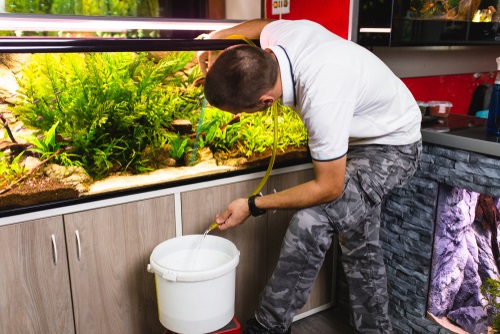
Maintaining your tank is essential for the well-being and health of your fish. A dirty tank can easily lead to diseases in your fish.
You can do a partial water change weekly or biweekly, by removing 30% of the water, especially siphoning it from the bottom of the tank, and replacing it with newly prepared water.
Make sure to clean dirty decorations and plants, and remove dead leaves from plants. A tank vacuum is ideal to clean your tank, and some species of fish such as Loaches, Platies, and Corydoras, as well as snails can help to clean your tank.
Likewise, keep in mind to regularly clean your tank filter to keep the water in good condition.
Feeding
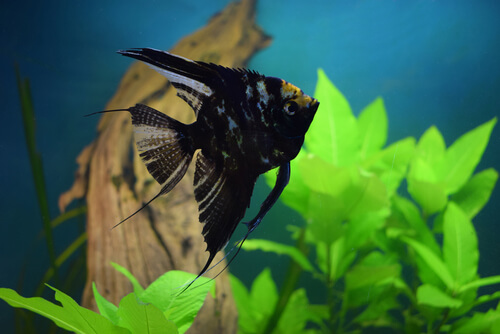
Angelfish in general are Omnivorous Freshwater fish that feed at the surface of the water, mid-water and that will forage for food at the bottom of the tank. “In the wild they feed mainly on insect larvae and small fishes”. To have a healthy Angelfish there needs to be a proper proportion of fiber to protein in their diet, they mostly choose a meat-based diet.
Their diet consists of high-quality pellets or flakes and frozen meat-based foods, as well as some vegetables.
How Often And How Much Should You Feed
Angelfish do not tend to be very picky eaters, and they will readily feed on different types of food, however, overfeeding can be a problem.
When feeding your fish only feed them once or twice a day and feed as much as they can finish in a few minutes.
Feeding Live Foods
Most Angelfish Species will feed on different types of live, or freeze-dried live foods these include;
- Tubifex worms and Fruit Flies (high in nutrients and protein)
- Bean Beetles and their larvae.
- Brine Shrimp.
- Flour Beetles.
- Chopped Earthworms.
- Black Soldier flies and larvae.
Ground Beef heart is sometimes used as a staple food, however, it can quickly degrade the quality of the water in your tank.
Feeding Vegetable Based Foods
Angelfish also enjoy vegetable or plant-based foods such as algae, algae wafers, and other leaf varieties. They enjoy Romaine and other types of lettuce, and spinach. Thinly sliced zucchini and marrow squash can be given. These foods however need to be blanched with boiling water and cooled down before feeding them to your fish.
Temperament And Personality
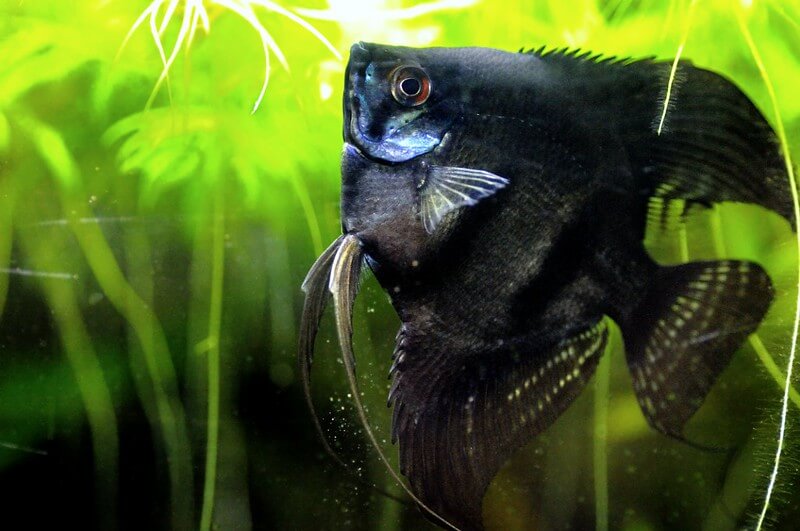
I might have mentioned a few things regarding the temperament of Angelfish, which will be the same for Black Angelfish. They are Peaceful fish that do enjoy tank mates of the same species and other species. They also tend to go to School.
When they get older they will eventually pair off, and then they do tend to get a bit more feisty and territorial. Angelfish do eat live smaller fish, as part of their nature thus they are not a good idea as a tank mate.
Common Health Issues
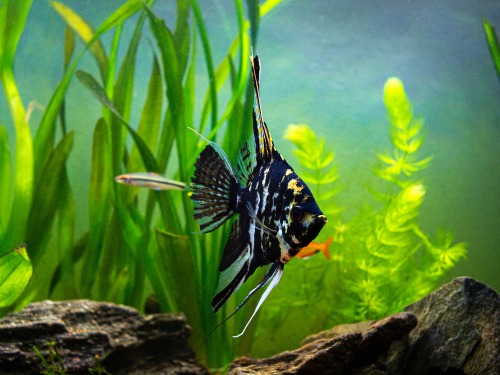
Your Black Angelfish and tank mates should stay in a healthy condition as long as your tank is kept clean and in optimal conditions, and if they are fed a healthy diet.
Here are some common conditions that mostly affect Angelfish;
1. Fin Rot
Fin Rot is a bacterial infection caused by fluctuating water conditions. It attacks the outer parts of the fins and moves inward slowly. By changing at least 30% or more of your tank’s water weekly you can prevent Fin rot, or treat it. Otherwise, a veterinarian could prescribe an antibiotic treatment.
2. Ich
Ich, or White Spot disease is caused mainly by stress as a result of poor tank conditions. A protozoan Parasite causes white itchy spots in the body of your fish. You also may notice your fish becoming lethargic and having a lack of appetite. You will need to quarantine the affected fish, until it is healthy again as the parasite will affect other fish.
3. Dropsy
Dropsy occurs because of a compromised immune system. Your Angelfish will become bloated and the scales may start to stick out, it will have rapid breathing, protruding eyes and a lack of appetite. A good prescription anti-bacterial medication from your veterinarian will help.
4. Physical Damage
Your Angelfish may likewise suffer physical damage from being handled, being nipped by other fish, or from hard and sharp parts on the decorations in their tank. It is best to avoid rough surfaces and sharp elements in their tanks, and to ensure that they are housed with non-aggressive tank mates.
Breeding And Hatchling Care
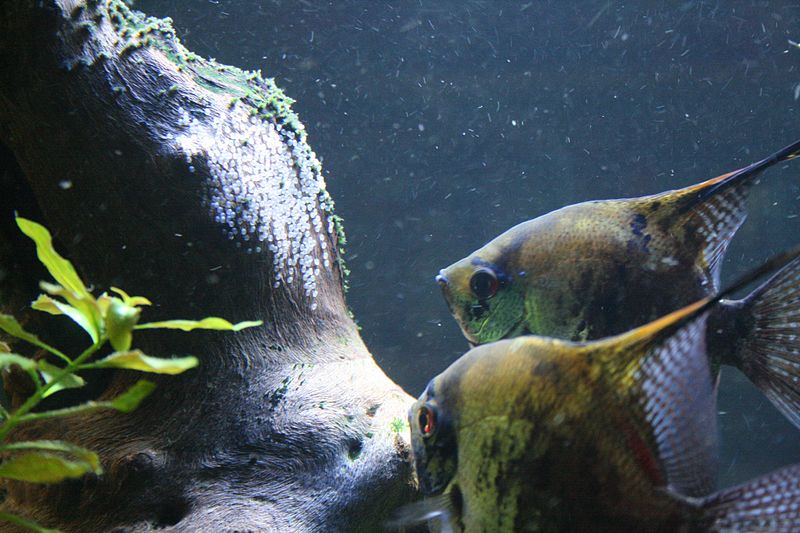
Breeding
Angelfish choose a partner to pair up with and will stay with that partner for life, usually protecting each other. They may even refuse a new partner should one die. Angelfish are mature at around six months to a year. It is good to keep them in Schools or groups so that they can choose a partner and pair off on their own.
You can read more about their mating rituals in How Do Angelfish Mate;
They will choose a safe spot to establish as their territory where they will spawn. The female will lay her eggs and the male will fertilize them, and they will continually move above and around the eggs to circulate the water.
It is stated that water quality and temperatures are essential for breeding successfully. “Try to maintain Angelfish at 24 degrees to 26 degrees Celsius for Spawning” and keep the pH levels between 6.8 to 7.2.
You can read more about their reproduction in the Aquaculture Extension.
Caring For The Eggs And Hatchlings
The Eggs will hatch in around 36 to 48 hours and the parents will chew the zygotes out of their egg shells. Though Angelfish may sometimes eat their hatchlings, they do eventually become nurturing parents taking care of their young.
You can leave the Angelfish to raise their own young, which will also depend on the other tank mates, or you can move them to a new tank. The youngsters can feed on baby brine shrimp from around 4 to 5 days of age.
To Conclude
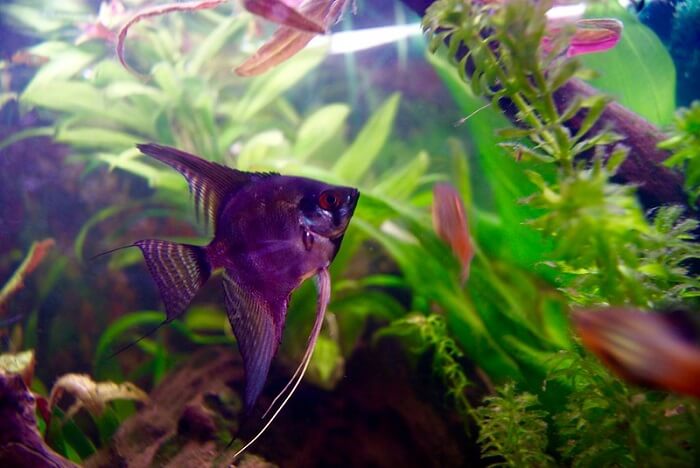
The Black Angelfish is a spectacular specimen of the FreshWater Angelfish species, with its dark color and red eyes. Angelfish, in general, are easy for beginners to keep, and easy to breed, with the added bonus that they can take care of their own young.
They can also easily be kept with many other species of fish, though they do tend to be slightly territorial.


